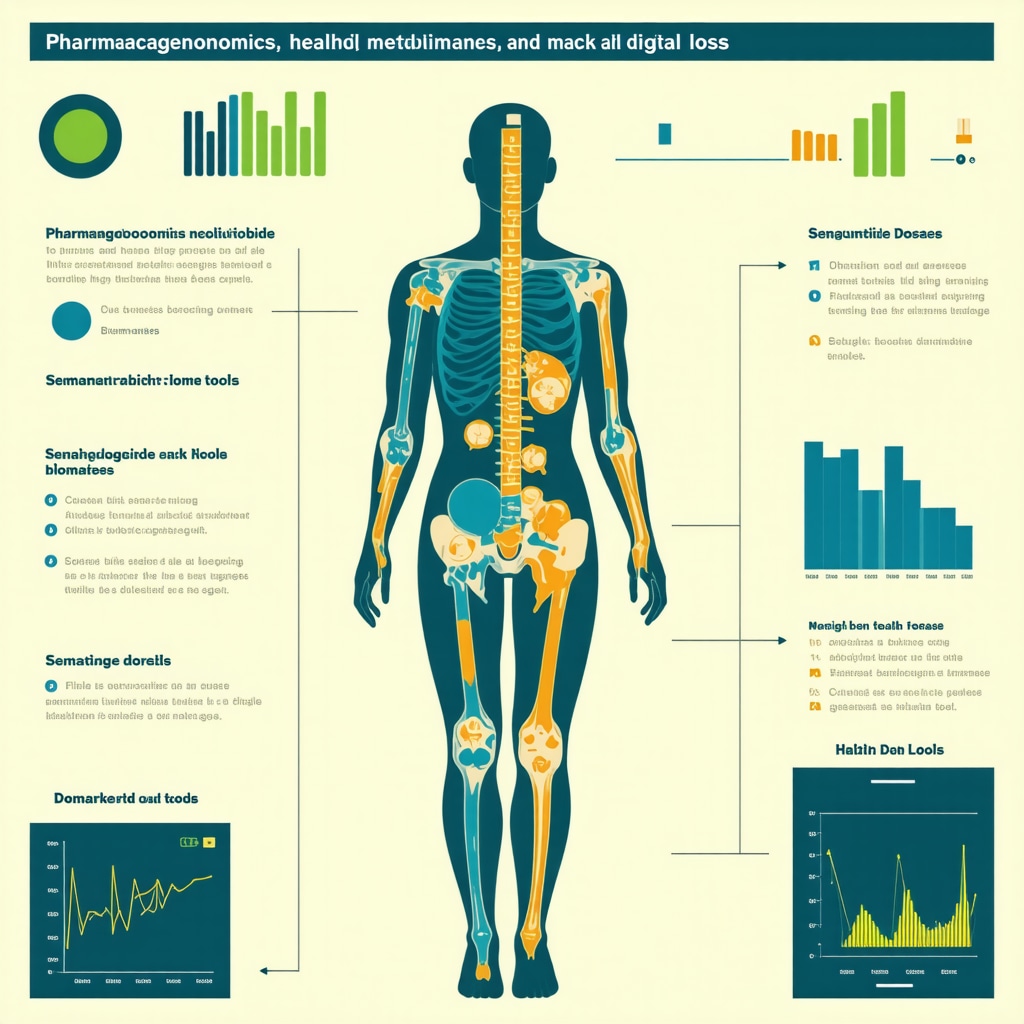Unlocking the Science Behind Semaglutide Dosage for Fat Loss
In the evolving landscape of weight management, semaglutide has emerged as a groundbreaking injectable medication, revered for its potent fat-burning capabilities. Understanding safe semaglutide dosages is crucial—not only to maximize fat loss but also to mitigate potential side effects. This expert guide delves into dosage strategies that optimize results while prioritizing safety, bridging clinical research with real-world application.
Precision in Practice: Tailoring Semaglutide Dosage to Individual Needs
Semaglutide dosage is not a one-size-fits-all prescription. Typically, treatment begins with a low dose of 0.25 mg per week to minimize gastrointestinal discomfort, progressively increasing every four weeks. The maintenance dose, often between 1 mg to 2.4 mg weekly, is tailored according to patient response and weight loss goals. This gradual titration exemplifies a clinical approach to balance efficacy and tolerability, informed by FDA-approved protocols.
How Do Experts Determine the Optimal Semaglutide Dose for Fat Loss?
Experts consider several factors, including baseline body mass index (BMI), metabolic health, and concurrent medications. For example, patients with obesity or type 2 diabetes may require higher maintenance doses for significant fat reduction, while those aiming for moderate weight loss might benefit from lower doses. Continuous monitoring allows adjustment to avoid adverse effects such as nausea or hypoglycemia. According to a pivotal study published in the New England Journal of Medicine, patients receiving 2.4 mg weekly achieved a mean weight loss of nearly 15% over 68 weeks, highlighting dose-dependent efficacy.
Mitigating Risks: Expert Recommendations for Safe Semaglutide Usage
Safety remains paramount. Expert guidelines emphasize initiating treatment under medical supervision, coupled with patient education on possible side effects such as gastrointestinal discomfort, pancreatitis risk, or thyroid concerns. Importantly, semaglutide is contraindicated in individuals with a history of medullary thyroid carcinoma or multiple endocrine neoplasia syndrome type 2. Regular follow-ups and dose adjustments are essential components of a responsible weight loss regimen.
Integrating Lifestyle for Amplified Fat Loss Impact
While semaglutide significantly aids fat loss, combining it with lifestyle modifications is indispensable. Incorporating a balanced diet and physical activity synergizes with medication effects. Moreover, emerging evidence supports pairing semaglutide with intermittent fasting to enhance metabolic efficiency and fat oxidation, as outlined in this strategic guide. Such integrative approaches ensure sustainable and healthful outcomes beyond pharmacotherapy alone.
Join the Conversation: Share Your Experiences with Semaglutide Dosage and Fat Loss
Have you embarked on a semaglutide weight loss journey or considered dosage optimization? Connect with experts and fellow users to exchange insights and support. Engaging with a community enriches understanding and empowers informed decisions on this transformative therapy.
Listening to Your Body: The Personal Journey of Semaglutide Dosage Adjustment
From my own experience and countless stories shared within weight loss communities, I’ve found that listening closely to your body’s signals is paramount when adjusting semaglutide dosage. While clinical guidelines provide a solid framework, every individual’s reaction to the medication can vary significantly. For instance, early on, I noticed mild nausea during the uptitration phase but found that maintaining hydration and adjusting meal timing helped immensely. This personalized approach to dosage ensures the medication’s benefits are maximized without compromising comfort or safety.
Healthcare providers play a crucial role here; regular check-ins allowed me to discuss side effects candidly and adjust my dose accordingly. If you’re starting or considering semaglutide, don’t hesitate to communicate openly with your doctor. They can tailor the dosage based on your unique metabolic response and lifestyle.
Beyond Dosage: How Diet and Activity Influence Semaglutide’s Effectiveness
Integrating semaglutide with a thoughtfully designed diet and consistent physical activity can amplify fat loss results. In my journey, pairing semaglutide with a diet rich in whole foods, lean proteins, and fiber made a noticeable difference. This helped manage appetite suppression effects positively, sustaining energy levels throughout the day.
Physical activity, even moderate daily walks, complemented the medication’s metabolic benefits. Interestingly, a recent review in Nutrients journal emphasizes how combining GLP-1 receptor agonists like semaglutide with lifestyle changes significantly improves weight loss outcomes and metabolic health, reinforcing the importance of a holistic approach.
What Are the Common Challenges When Combining Semaglutide with Lifestyle Changes?
One challenge I faced was balancing the appetite reduction from semaglutide with maintaining proper nutrition — it’s easy to unintentionally under-eat, which can lead to fatigue or nutrient deficiencies. Also, some days the motivation for exercise dips, especially when adjusting to new routines or dealing with mild side effects. These hurdles require patience and sometimes tweaking your plan with professional guidance.
Adapting meals to smaller, nutrient-dense portions and scheduling regular gentle exercise helped me stay consistent. It’s also valuable to track progress and setbacks honestly, allowing for timely adjustments. I encourage anyone on this path to explore detailed guides like crafting the best doctor-supervised semaglutide diet plan to build a sustainable routine.
Encouraging Open Conversations: Your Semaglutide Stories Matter
Weight loss journeys are deeply personal and often complex. Sharing your experiences with semaglutide dosage, side effects, lifestyle integration, or unexpected challenges can be incredibly empowering—not just for you but for others navigating similar paths. Whether you’ve just started or are weeks into your treatment, your insights can help shape a supportive community.
If you feel comfortable, reach out and share your story or tips. Sometimes, the most valuable lessons come from real-life experiences rather than clinical data alone. Together, we can foster a richer understanding of how to use semaglutide safely and effectively for fat loss.
Pharmacogenomics: Tailoring Semaglutide Dosage Through Genetic Insights
The burgeoning field of pharmacogenomics offers an intriguing frontier for personalized semaglutide therapy. Variations in genes encoding GLP-1 receptor sensitivity, drug metabolism enzymes, and appetite regulation pathways can influence individual responsiveness to semaglutide. For instance, polymorphisms in the GLP1R gene may modulate receptor binding affinity, potentially necessitating adjusted dosing strategies to achieve optimal fat loss outcomes.
Incorporating genetic screening prior to treatment initiation could revolutionize dosing precision, minimizing trial-and-error titration phases and reducing adverse effects. Although this approach is not yet mainstream, ongoing research underscores its promise in refining semaglutide therapy, particularly for patients exhibiting suboptimal response or intolerance at standard doses.
Advanced Dose Titration Protocols: Balancing Potency and Patient Tolerability
Beyond the conventional incremental titration, advanced protocols explore micro-dosing adjustments and adaptive titration schedules based on real-time patient feedback and biomarkers. For example, some clinicians employ weekly dose increments as low as 0.1 mg, guided by continuous glucose monitoring and appetite scales, to finely calibrate semaglutide’s anorectic effects.
This granular approach can be particularly beneficial for patients with heightened gastrointestinal sensitivity or comorbidities affecting drug metabolism. Additionally, leveraging telemedicine platforms facilitates close monitoring and rapid dose modifications, ensuring a dynamic, patient-centric dosing regimen that maximizes fat loss efficacy while safeguarding well-being.
How Do Metabolic Biomarkers Inform Semaglutide Dose Adjustments in Clinical Practice?
Metabolic biomarkers such as fasting insulin, C-peptide levels, and inflammatory markers (e.g., CRP) provide insights into a patient’s metabolic state and can guide semaglutide dosing strategies. Elevated insulin resistance, for instance, might warrant higher doses or combination therapy to overcome compensatory hyperinsulinemia and improve fat oxidation.
Regular assessment of these biomarkers enables clinicians to personalize dosage adjustments beyond weight-centric metrics, optimizing both fat loss and metabolic health. A comprehensive review published in Frontiers in Endocrinology discusses the integration of biomarker-guided therapy in GLP-1 receptor agonist treatment, emphasizing improved patient outcomes.
Addressing Semaglutide Tolerance and Resistance: Strategies for Sustained Fat Loss
Long-term semaglutide use occasionally encounters diminished efficacy, attributable to receptor desensitization or compensatory physiological adaptations. Addressing tolerance requires multifaceted strategies, including dose cycling, adjunctive pharmacotherapy, or incorporating intermittent treatment holidays under medical supervision.
Adjunctive agents targeting complementary pathways—such as SGLT2 inhibitors or amylin analogs—may potentiate semaglutide’s effects, counteracting resistance mechanisms and sustaining fat loss momentum. This nuanced pharmacological orchestration demands expert oversight to balance synergistic benefits against cumulative side effect profiles.
Harnessing Digital Health Tools for Real-Time Semaglutide Dose Optimization
The integration of digital health technologies—wearable devices, mobile apps, and AI-driven analytics—empowers patients and clinicians with actionable data to refine semaglutide dosing dynamically. Continuous tracking of parameters like physical activity, dietary intake, glucose variability, and subjective appetite ratings enables a holistic overview of treatment impact.
Such real-time feedback fosters adaptive dose titration, early side effect detection, and enhanced adherence. Furthermore, patient engagement through digital platforms enhances motivation and self-efficacy, critical components for enduring lifestyle changes that complement pharmacotherapy.

Can Digital Therapeutics Replace Traditional Monitoring in Semaglutide Treatment?
While digital therapeutics offer transformative potential, they are envisioned as complementary rather than replacements for traditional clinical monitoring. They augment clinician insight with granular, continuous data that may be inaccessible during periodic visits, enabling preemptive interventions and personalized dose refinement. However, limitations such as data accuracy, patient digital literacy, and privacy concerns necessitate balanced integration within comprehensive care models.
Engaging with specialized digital health solutions designed for weight management can accelerate semaglutide’s benefits. Explore our curated resources on digital health innovations in fat loss to harness technology alongside expert pharmacotherapy guidance.
Pharmacological Nuances: Leveraging Pharmacodynamics for Enhanced Semaglutide Efficacy
Understanding semaglutide’s pharmacodynamics intricacies enables clinicians to fine-tune dosages beyond standard protocols. The drug’s mechanism involves GLP-1 receptor activation, which modulates insulin secretion, appetite suppression, and gastric emptying. Variability in receptor expression and downstream signaling pathways can significantly impact individual responses. Advanced dose adjustments consider these molecular dynamics, aiming to sustain receptor sensitivity and maximize adipose tissue mobilization.
Integrating Multimodal Approaches: Combining Semaglutide with Adjunct Therapies for Synergistic Fat Loss
Emerging evidence advocates for a multimodal strategy wherein semaglutide is combined with complementary pharmacotherapies or nutraceuticals targeting distinct metabolic pathways. For instance, co-administration with SGLT2 inhibitors enhances glycosuria-induced caloric loss, while amylin analogs potentiate satiety effects. This integrative pharmacological approach necessitates expert oversight to tailor regimens that optimize fat loss while minimizing adverse event profiles.
How Can Advanced Biomarker Profiling Refine Semaglutide Dose Personalization?
Advanced biomarker profiling involves assessing parameters such as adipokine levels, gut hormone profiles, and metabolomic signatures to delineate patient-specific physiological landscapes. This data informs dosing decisions by identifying metabolic bottlenecks or compensatory mechanisms that might attenuate semaglutide’s efficacy. A landmark review in Frontiers in Endocrinology underscores the potential of integrating biomarker analytics in GLP-1 receptor agonist therapy to enhance precision medicine paradigms.
Exploring Patient-Centric Digital Ecosystems for Dynamic Dosage Modulation
The advent of AI-powered digital ecosystems facilitates continuous, patient-centric dosage modulation by aggregating real-time physiological and behavioral data. Machine learning algorithms predict optimal titration schedules, anticipate adverse reactions, and provide personalized lifestyle recommendations, thereby enhancing adherence and efficacy. This paradigm shift towards digital therapeutics represents a frontier in obesity pharmacotherapy, demanding interdisciplinary collaboration among clinicians, data scientists, and patients.

What Are the Challenges and Ethical Considerations in Implementing AI-Driven Semaglutide Dosing Platforms?
While AI-driven dosing platforms herald precision and scalability, they introduce challenges including data privacy, algorithmic bias, and the necessity for transparent decision-making frameworks. Ensuring equitable access and maintaining clinician oversight are critical to mitigating risks associated with overreliance on automated systems. Ethical deployment requires rigorous validation studies and stakeholder engagement to foster trust and optimize clinical outcomes.
Call to Action: Engage with Cutting-Edge Semaglutide Dosage Innovations
To capitalize on these advanced insights, healthcare professionals and patients alike are encouraged to explore emerging technologies and personalized medicine strategies that redefine semaglutide dosing. Delve deeper into expert analyses, join specialized forums, and collaborate with multidisciplinary teams to harness the full potential of semaglutide for fat loss. Your proactive involvement can accelerate innovation and improve therapeutic success.
Frequently Asked Questions (FAQ)
What is the recommended starting dose of semaglutide for fat loss?
The typical initiation dose is 0.25 mg once weekly, primarily to reduce gastrointestinal side effects. This dose is usually increased every four weeks, based on tolerance and efficacy, until reaching a maintenance dose between 1 mg and 2.4 mg weekly.
How long does it take to see fat loss results with semaglutide?
Clinical studies show significant fat loss can occur over 12 to 68 weeks of treatment. Most patients begin noticing appetite suppression and weight reduction within the first few weeks, but sustained fat loss usually requires several months of consistent dosing and lifestyle integration.
Can semaglutide dosage be personalized based on genetic factors?
Emerging pharmacogenomic research indicates that genetic variations, particularly in the GLP1R gene, may influence individual responses to semaglutide. While routine genetic screening is not yet standard practice, it holds promise for future personalized dosing regimens to optimize efficacy and minimize side effects.
What are common side effects and how can they be managed during dosage titration?
Gastrointestinal symptoms such as nausea, vomiting, and diarrhea are common, especially during dose escalation. Strategies to manage these include gradual dose increases, staying hydrated, eating smaller nutrient-dense meals, and consulting healthcare providers for tailored adjustments.
Is it safe to combine semaglutide with intermittent fasting or other lifestyle changes?
Yes, combining semaglutide with a balanced diet, physical activity, and intermittent fasting can amplify fat loss benefits. However, it is important to maintain adequate nutrition and monitor for symptoms like fatigue or dizziness. Coordination with healthcare professionals is advised to tailor these approaches safely.
How do metabolic biomarkers guide semaglutide dosing adjustments?
Biomarkers such as fasting insulin, C-peptide, and inflammatory markers provide insight into metabolic health and insulin resistance. Monitoring these helps clinicians personalize dosing beyond weight metrics, enhancing fat loss and metabolic improvements by adjusting doses responsive to physiological changes.
What strategies exist for addressing tolerance or resistance to semaglutide?
Tolerance may develop due to receptor desensitization or physiological adaptations. Approaches to mitigate this include dose cycling, intermittent drug holidays, or combining semaglutide with adjunct therapies like SGLT2 inhibitors to sustain fat loss efficacy under medical supervision.
Can digital health tools replace traditional clinical monitoring during semaglutide treatment?
Digital therapeutics complement but do not replace traditional clinical care. They provide continuous data on activity, nutrition, and physiological responses, enabling dynamic dose adjustments and early side effect detection, enhancing patient engagement and treatment personalization.
What are ethical considerations when implementing AI-driven semaglutide dosing platforms?
Key concerns include data privacy, algorithm transparency, and mitigating biases. Ensuring clinician oversight and equitable access is essential to maintain trust and safety, requiring rigorous validation and stakeholder involvement before widespread adoption.
Trusted External Sources
- New England Journal of Medicine (NEJM) – Provides seminal clinical trials on semaglutide efficacy and dosing protocols, offering evidence-based insights into its weight loss impact.
- Frontiers in Endocrinology – Features comprehensive reviews on integrating biomarker-guided therapy and pharmacogenomics in GLP-1 receptor agonist treatment, critical for personalized dosing strategies.
- National Center for Biotechnology Information (NCBI) – Nutrients Journal – Publishes research on lifestyle interventions combined with pharmacotherapy, underpinning the role of diet and activity in augmenting semaglutide outcomes.
- American Diabetes Association (ADA) – Offers clinical practice recommendations and safety guidelines for GLP-1 receptor agonists, essential for safe and effective semaglutide use.
- Obesity Society – Provides expert consensus on multimodal obesity management, including adjunct pharmacotherapies and digital health innovations supporting semaglutide treatment.
Conclusion
Semaglutide has redefined fat loss pharmacotherapy by combining potent appetite suppression with metabolic benefits, yet its success hinges on thoughtful, individualized dosing strategies. From gradual titration to advanced biomarker and genetic profiling, tailoring semaglutide dosage enhances efficacy while safeguarding safety. Integrating lifestyle modifications and leveraging digital health tools further amplifies outcomes, fostering sustainable weight management. Understanding and addressing challenges like tolerance, side effects, and ethical considerations in AI-guided dosing fortify a holistic and patient-centric approach.
Empowered with these expert insights, healthcare providers and patients can navigate semaglutide therapy with confidence and precision. We invite you to share your experiences, explore emerging research, and engage with our community to unlock semaglutide’s full potential in fat loss. Together, let’s advance towards optimized, safe, and effective weight management solutions.


What really stood out to me in this comprehensive post is the emphasis on individualized dosing of semaglutide. The gradual titration approach makes sense, especially given the potential gastrointestinal side effects that many experience during dose escalation. In my experience, starting low and increasing slowly really helped reduce nausea early on. However, I wonder how clinicians balance the need for effective fat loss with patient tolerance, especially in those with heightened sensitivity to medications. Also, the discussion around pharmacogenomics is intriguing — tailoring doses based on genetic profiles could revolutionize treatment, but it seems like we’re still in the early days of this practice. Has anyone here had experiences where dosing required multiple adjustments beyond the standard protocol to find what truly worked for them? I’m curious how others manage lifestyle factors especially when appetite suppression makes consistent nutrition challenging. Integrating semaglutide with diet and exercise appears essential but also tricky to navigate. It would be great to hear how readers reconcile these challenges or make real-time dosing adjustments under medical guidance to optimize outcomes without feeling overwhelmed by side effects or lifestyle changes.
Michael’s question on balancing effective fat loss while managing tolerance, especially in sensitive individuals, really resonates with me. In my experience, communication with my healthcare provider was key. We adjusted my semaglutide dose incrementally, sometimes pausing increases, to handle the nausea without sacrificing progress. It felt like a personalized dance between efficacy and comfort. The article’s point about integrating lifestyle changes—diet and physical activity—cannot be overstated. I’ve found that when semaglutide suppresses appetite, planning nutrient-dense small meals helped me maintain my energy levels. Also, incorporating intermittent fasting as mentioned aligns with improved metabolic efficiency, but it requires close monitoring to avoid fatigue or dizziness. I’m curious about others’ approaches: how do you effectively combine semaglutide’s appetite modulation with sustaining proper nutrition? Moreover, has anyone explored or experienced benefit from using digital health tools for real-time feedback during their dose adjustments? The idea of AI-assisted titration seems promising but also raises questions about how user-friendly and accessible these tools really are for everyday patients.